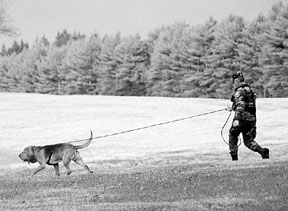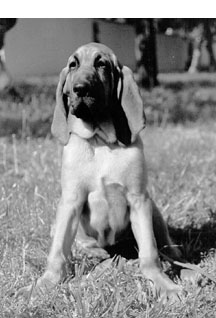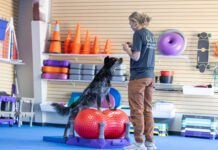One of the cool things about dogs is the variety of tasks, tricks, and trades they can learn. Dogs perform lifesaving work in search and rescue and criminal justice venues, and they are employed to detect everything from prohibited fruits, vegetables and meats in airports to termites in homes. These abilities are directly related to their sense of smell. All dogs have a highly developed sense of smell, although some breeds – primarily scenthounds and sporting dogs – show greater ability than others.
A powerful nose is the first requirement for identifying or tracking down weapons, accelerants, explosives, drugs, food, missing persons, bodies hidden under water or beneath mounds of snow. The dog must also be highly intelligent, with the ability to think independently and solve complex scent problems. However, the dog needs more than these gifts of nature in order to be effective in this line of work. According to experts in scent-dog training, these talented dogs must be handled and trained with a simple but highly effective technique: positive reinforcement. No other training method is as effective in producing competent, reliable, and willing scent dogs.
Pure, positive power

Numerous articles in WDJ have described the effectiveness of positive training for teaching dogs to exhibit general “manners” and acceptable behavior. But while positive reinforcement techniques enjoy generally widespread acceptance among “pet dog” trainers, some old-school trainers believe that their use – especially when food is involved – don’t result in a dog that responds with precision and reliability. Treats and other positive reinforcements are best used for trick training, they say.
The professionals who train scent dogs for police work and other serious duties would take issue with that opinion, however.
If confronted with a person who feels that treats are only good for teaching tricks, “I would tell them to watch a well-trained mantrailing Bloodhound at work,” says trainer and Illinois law enforcement officer Jack Shuler, who has worked with mantrailing Bloodhounds for 22 years.
“Their drive, determination, dedication, and single-mindedness to find the source of the scent trail they are following is beyond compare and certainly cannot be called a ‘trick,’ and all this is achieved through training with positive reinforcement,” says Shuler. “Another good example would be a narcotics detection dog. He will work for hours hunting the smell of illicit drugs just to get to play with a tennis ball or towel for a couple of minutes.”
No place for force
As Shuler points out, most dogs can be intimidated and even physically compelled to comply with simple commands like Sit and Down. But following a scent trail or identifying items by their scent is not the kind of skill that any dog can be forced to exhibit. It’s true that scent dogs may naturally demonstrate a high degree of curiosity with their noses, sniffing at anything that interests them. But the ability to differentiate between and indicate the presence of specific scents is something that can be taught only with rewards for making correct decisions. And, as is customary with the positive reinforcement approach, when the dog makes incorrect decisions, he is either ignored or gently redirected.
“You can’t make a dog use his nose,” explains Sandy Seward, an instructor with the United States Department of Agriculture’s Beagle Brigade in Orlando, Florida. “They’ve got to want to do it. So, as a trainer, you must not only understand how a dog’s mind operates and how he perceives stimuli around him or your actions toward him, but you’ve also got to make it a game for him, make it worth his while.”
The rewards that make a dog’s efforts worthwhile range from tone of voice to tug-of-war games to well-timed treats. Words themselves are not especially meaningful to dogs, but a high-pitched tone of excitement or a soothing monotone can get results, no matter what the trainer actually says. The promise of a ball to be thrown or the offer of a treat can lure a dog, giving him the incentive to try things he might not otherwise be interested in doing on his own.
These small rewards may seem insignificant to us, but their power to motivate a food- and fun-oriented dog is Herculean. Take it from police officer Jeff Schettler, of Alameda, California. His partner on the force is a Bloodhound named Ronin. “Cookies are a good tool to get Ronin to try things he is afraid of,” Schettler says.
“The food drive is directly related to the prey drive, in my opinion. For example, Ronin is normally afraid of creeks and lakes. He will get his feet wet, but he won’t swim. When we are working, though, he will actually swim to get to his ‘victim.’ Around the house and when we aren’t working, he is afraid of loud, sharp noises, but when he’s on the trail he could care less. On one occasion we were shot at, and he ignored it completely. It’s kind of amazing.”
Creative, individual approach
Trying to figure out what reward will work with a particular dog is one of the challenges of training. It often requires creativity and the constant reminder that each dog is an individual. “With some dogs you can just say ‘Find it’ with an exciting uplift at the end of your request,” Seward says, “but with this last group of dogs I trained, I could not get one dog interested in coming up to and sniffing any of the boxes, no matter what I did. In desperation, I made a really high-pitched, squirrelly noise while I was tapping the box I wanted him to investigate, and that finally aroused his curiosity. Every dog is different.”
To keep her creative juices flowing, Seward keeps a list of tricks that have worked with all the dogs she has trained. As she trains, she takes extensive notes on each dog’s reactions. “I start with five or six dogs at a time, each presenting four or five separate scenarios that cause me to reach into my bag of tricks. As I get to each dog, I refer to my notes, which tell me, ‘This is the dog I’ve got to move fast with’; ‘This is the dog that needs lots of gestures’; or ‘This is the dog that shies away from gestures.’ ”
Besides being creative in finding rewards, trainers must also be creative in solving problems. While it’s easy to yell at a dog for doing something wrong, it’s not so easy to find a positive way to motivate him or to prevent failure. One of the tenets of positive reinforcement is that a dog is never allowed to fail.
“If the dog has a difficult time working through a training problem, the handler and victim work as a team to help the dog through it,” says South Pasadena, California, police officer Dennis Slavin. “I like to use one of the dog’s favorite ‘victims’ – usually my wife – to introduce complicated problems and difficult trails. The dog is more motivated than usual to find that favorite person and works harder at solving the problem.”
If positive reinforcement seems like a lot of effort, it certainly can be. The rewards for the trainer, however, are proportionately greater. “It seems to take a little bit longer for the dogs to evolve sometimes, but I think it works better because you have a more positive relationship with the animal. It’s more of a partner relationship rather than a master-type relationship,” Schettler says.
Not only does positive reinforcement make sense as far as getting the dog to respond to training, it’s also the best way to interact with often sensitive dogs. Hounds in particular are known for their gentle, somewhat shy temperaments. “It was stressed to me early by my mentors, Glenn Rimbey and Kat Albrecht, that bloodhounds don’t respond well to discipline, physical discipline, in particular,” Schettler says. “They can be unusually sensitive and have incredible memories. Once exposed to a negative, they never forget.”
But no matter what the breed, positive reinforcement works well with any aspect of training, primarily because it’s stress-free. We know that humans learn more quickly and eagerly in an accepting environment, and dogs are no different. The attention he receives when he performs in the desired manner encourages a dog to repeat that behavior.
No negatives!
When is it OK to punish a scent-dog-in-training? Never is the unanimous response. “If a dog is not doing something I want him to do, the way I may punish him, if you want to use that word, is just by ignoring him, withdrawing attention,” Seward says. “When a dog is stressed, say through physical or verbal correction, he can’t readily learn or absorb what it is you’re trying to convey.”
In fact, negative reinforcement can backfire when used with sensitive dogs. “Bloodhounds get their feelings hurt very easily,” concurs Shuler. “The techniques used in the training of ‘harder’ breeds of dogs, such as those used for police patrol work, would totally devastate a Bloodhound. Bloodhounds are very devoted to their people, and positive training techniques encourage them to do exactly what their human wants them to do.”
When a dog makes a mistake, the best response is to ignore the error and gently refocus him on the task at hand. Any number of things could have caused the mistake, from inexperience to eagerness to confusion. “It’s possible that somebody walked by with a bag with odor as the dog was sniffing a bag with no odor,” Seward says. “Because the odor happened to go into his nasal cavity at that particular time, his inexperience may cause him to make an alert. But if you do something aversive to the dog, you may be stifling his ability to blossom into the more precise and accurate detector dog that you expect down the line. You have to expect mistakes.”
When working with scent dogs, the handler also has to be sensitive to the fact that if a mistake is made, it’s just as likely to be the handler’s fault as the dog’s, making punishment for the dog even more inappropriate. Schettler learned this early in his work with Ronin. The two had worked six or seven cases, following some good trails, but had yet to find anyone. Then they were sent out on a missing person search.
“The lady had been missing for four days,” Schettler describes. “Her car was found in a cornfield and appeared to have been ransacked. It looked like a crime scene, and everybody feared the worst. I started Ronin, and within about an hour and a half he found a lady, hiding in some bushes and cattails. I didn’t see her at all. Ronin just ran into the bushes, and the next thing I knew he was standing in this lady’s lap. I was shocked, and I didn’t think it was the one we were looking for. I almost told Ronin to get back on the trail. But then I asked her who she was, and she wouldn’t tell me. I started looking at her, and the description matched. It turned out that she had a fear of society and didn’t want to come back.”
Once Schettler knew that Ronin had found the correct person, he hurried to praise the dog for his success. To keep the dogs motivated, handlers must be sure that their dogs are praised and positively reinforced for each of their successes, no matter what kind of chaos arises as a result of their find.
“A Bloodhound does not differentiate ‘bad guy’ trails from ‘good guy’ trails,” Slavin says. “As far as the hound is concerned, once she is scented on the person she is looking for, her goal is to find that person so she can be overwhelmed with praise and affection. For this reason, it’s important for us to follow a criminal trail – in which the prey is never happy to be found – with a short positive trail on a person who will join in praising the hound. This helps to maintain the hound’s enthusiasm and confidence.”
Treats are no trick
Unfortunately, there are still numerous trainers who learned how to train dogs primarily by punishing the dog’s undesired behavior, and who just don’t believe that treats and praise can be used to shape a dog’s behavior the way they’d like. “My first instinct in response to that attitude is to say ‘Try it, you might like it,’ ” says Seward, who describes herself as a “crossover” trainer. “I came from the old school, and I can appreciate that train of thought because I used to be there.
“Once I tried it, though, I found that I got much more out of the dog, and the training sessions could last longer, with the dog retaining much more of what I was trying to get him to do. I think a lot of the resistance is just lack of understanding of the mechanics of how the dog assimilates information.” Seward’s greatest successes, she says, are when she sees positive reinforcement techniques change a dog whose status is shaky. “It’s great when I’m able to take a dog that probably shouldn’t ever have gotten into the program, one we refer to as a borderline dog, and watch the positive reinforcement reshape the way this dog interprets my actions toward him.”
-By Kim Thornton
Kim Thornton is a freelance writer living in Lake Forest, CA.






